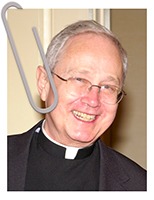 Fr. Pat Griffin of the Eastern Province of the Congregation of the Mission offers insights into the in-between-time of our lives.
Fr. Pat Griffin of the Eastern Province of the Congregation of the Mission offers insights into the in-between-time of our lives.
We sometimes refer to that period which is sandwiched between two events as an “in-between” time. The occurrences which flank this interval often provide its character and purpose. The unifying force of the interlude draws the two poles together in a manner which gives direction to the whole. “In-between” time enables one to reflect upon the meaning of one happening and prepare for the next. It reminds us that we are always on a journey. Attention to this interval confirms where we have been and primes us for what is to come. It is like the silence between notes of music, the break between words in poetry, the rest between exertions.
On occasion, I have been drawn to reflect upon some of the in-between times which the New Testament and the liturgical year offer to us. These are times about which we know little but which are defined by great events. Holy Saturday seems like one of those times for me. For the apostles, it is the time between death and Resurrection. One could also consider the time between the incarnation and the nativity; between the presentation and the beginning of the public ministry (with the story of the “finding in the Temple” offering a break); and so forth.
Right now, I am focusing on the ten days between the Ascension and Pentecost. For the forty days previous to the Ascension, the resurrected Lord had been appearing to the members of the early Christian community. We have been reading some of these stories, and are told that there were other encounters. Remember how Luke begins the Acts of the Apostles:
In the first book, Theophilus, I dealt with all that Jesus did and taught until the day he was taken up, after giving instructions through the holy Spirit to the apostles whom he had chosen. He presented himself alive to them by many proofs after he had suffered, appearing to them during forty days and speaking about the kingdom of God. While meeting with them, he enjoined them not to depart from Jerusalem, but to wait for “the promise of the Father about which you have heard me speak; for John baptized with water, but in a few days you will be baptized with the holy Spirit.” (Acts 1:1-5)
This gift of the Holy Spirit would deepen the disciples understanding of Jesus and their ministry. The preparation for Pentecost was to give the community an opportunity to get themselves ready to change and be changed. I envision it as a time of quiet, openness and, perhaps, some eagerness.
I think that this period may have had some particular importance for our Founders. We know the circumstances surrounding the lumière, and how it influenced Louise’s later thinking.
Louise regarded the period between Ascension and Pentecost as a time of special grace. She encouraged her Sisters to make a retreat during this time of waiting and praying for the Holy Spirit to come in fullness. (Regina Bechtle, “From Ascension to Pentecost: A Mini-Retreat in the Spirit of St. Louise de Marillac”)
This time of waiting corresponds to their willingness to trust in Divine Providence.
I can think of many situations in my life where the gift of the Holy Spirit would be welcome. The current in-between time provides a chance to seek and accept. Come, Holy Spirit.
(This post originally appeared on Famvin.)


Thanks,again,Father Pat! Your wisdom is a most encouraging meditation. Indeed,the Holy Spirit is gracing us during all of our “in-betweens”. These are touches of heaven while we are living on earth!
Most Gratefully,
Ed Ambrose,AA,St. Joe’s,1957